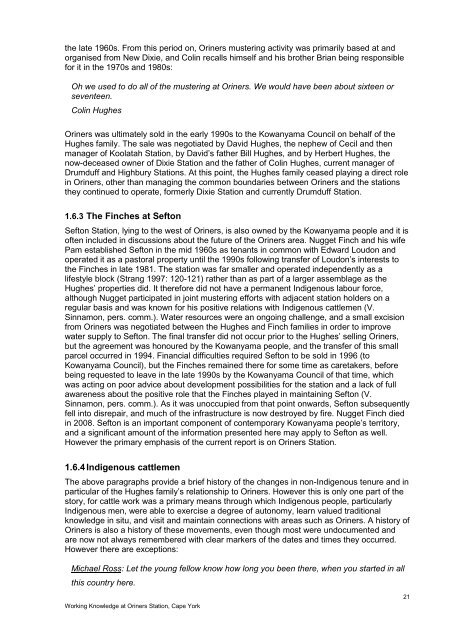WfHC - cover page (not to be used with pre-printed report ... - CSIRO
WfHC - cover page (not to be used with pre-printed report ... - CSIRO
WfHC - cover page (not to be used with pre-printed report ... - CSIRO
Create successful ePaper yourself
Turn your PDF publications into a flip-book with our unique Google optimized e-Paper software.
the late 1960s. From this period on, Oriners mustering activity was primarily based at and<br />
organised from New Dixie, and Colin recalls himself and his brother Brian <strong>be</strong>ing responsible<br />
for it in the 1970s and 1980s:<br />
Oh we <strong>used</strong> <strong>to</strong> do all of the mustering at Oriners. We would have <strong>be</strong>en about sixteen or<br />
seventeen.<br />
Colin Hughes<br />
Oriners was ultimately sold in the early 1990s <strong>to</strong> the Kowanyama Council on <strong>be</strong>half of the<br />
Hughes family. The sale was negotiated by David Hughes, the nephew of Cecil and then<br />
manager of Koolatah Station, by David‟s father Bill Hughes, and by Her<strong>be</strong>rt Hughes, the<br />
now-deceased owner of Dixie Station and the father of Colin Hughes, current manager of<br />
Drumduff and Highbury Stations. At this point, the Hughes family ceased playing a direct role<br />
in Oriners, other than managing the common boundaries <strong>be</strong>tween Oriners and the stations<br />
they continued <strong>to</strong> operate, formerly Dixie Station and currently Drumduff Station.<br />
1.6.3 The Finches at Sef<strong>to</strong>n<br />
Sef<strong>to</strong>n Station, lying <strong>to</strong> the west of Oriners, is also owned by the Kowanyama people and it is<br />
often included in discussions about the future of the Oriners area. Nugget Finch and his wife<br />
Pam established Sef<strong>to</strong>n in the mid 1960s as tenants in common <strong>with</strong> Edward Loudon and<br />
operated it as a pas<strong>to</strong>ral property until the 1990s following transfer of Loudon‟s interests <strong>to</strong><br />
the Finches in late 1981. The station was far smaller and operated independently as a<br />
lifestyle block (Strang 1997: 120-121) rather than as part of a larger assemblage as the<br />
Hughes‟ properties did. It therefore did <strong>not</strong> have a permanent Indigenous labour force,<br />
although Nugget participated in joint mustering efforts <strong>with</strong> adjacent station holders on a<br />
regular basis and was known for his positive relations <strong>with</strong> Indigenous cattlemen (V.<br />
Sinnamon, pers. comm.). Water resources were an ongoing challenge, and a small excision<br />
from Oriners was negotiated <strong>be</strong>tween the Hughes and Finch families in order <strong>to</strong> improve<br />
water supply <strong>to</strong> Sef<strong>to</strong>n. The final transfer did <strong>not</strong> occur prior <strong>to</strong> the Hughes‟ selling Oriners,<br />
but the agreement was honoured by the Kowanyama people, and the transfer of this small<br />
parcel occurred in 1994. Financial difficulties required Sef<strong>to</strong>n <strong>to</strong> <strong>be</strong> sold in 1996 (<strong>to</strong><br />
Kowanyama Council), but the Finches remained there for some time as caretakers, <strong>be</strong>fore<br />
<strong>be</strong>ing requested <strong>to</strong> leave in the late 1990s by the Kowanyama Council of that time, which<br />
was acting on poor advice about development possibilities for the station and a lack of full<br />
awareness about the positive role that the Finches played in maintaining Sef<strong>to</strong>n (V.<br />
Sinnamon, pers. comm.). As it was unoccupied from that point onwards, Sef<strong>to</strong>n subsequently<br />
fell in<strong>to</strong> disrepair, and much of the infrastructure is now destroyed by fire. Nugget Finch died<br />
in 2008. Sef<strong>to</strong>n is an important component of contemporary Kowanyama people‟s terri<strong>to</strong>ry,<br />
and a significant amount of the information <strong>pre</strong>sented here may apply <strong>to</strong> Sef<strong>to</strong>n as well.<br />
However the primary emphasis of the current <strong>report</strong> is on Oriners Station.<br />
1.6.4 Indigenous cattlemen<br />
The above paragraphs provide a brief his<strong>to</strong>ry of the changes in non-Indigenous tenure and in<br />
particular of the Hughes family‟s relationship <strong>to</strong> Oriners. However this is only one part of the<br />
s<strong>to</strong>ry, for cattle work was a primary means through which Indigenous people, particularly<br />
Indigenous men, were able <strong>to</strong> exercise a degree of au<strong>to</strong>nomy, learn valued traditional<br />
knowledge in situ, and visit and maintain connections <strong>with</strong> areas such as Oriners. A his<strong>to</strong>ry of<br />
Oriners is also a his<strong>to</strong>ry of these movements, even though most were undocumented and<br />
are now <strong>not</strong> always remem<strong>be</strong>red <strong>with</strong> clear markers of the dates and times they occurred.<br />
However there are exceptions:<br />
Michael Ross: Let the young fellow know how long you <strong>be</strong>en there, when you started in all<br />
this country here.<br />
Working Knowledge at Oriners Station, Cape York<br />
21
















